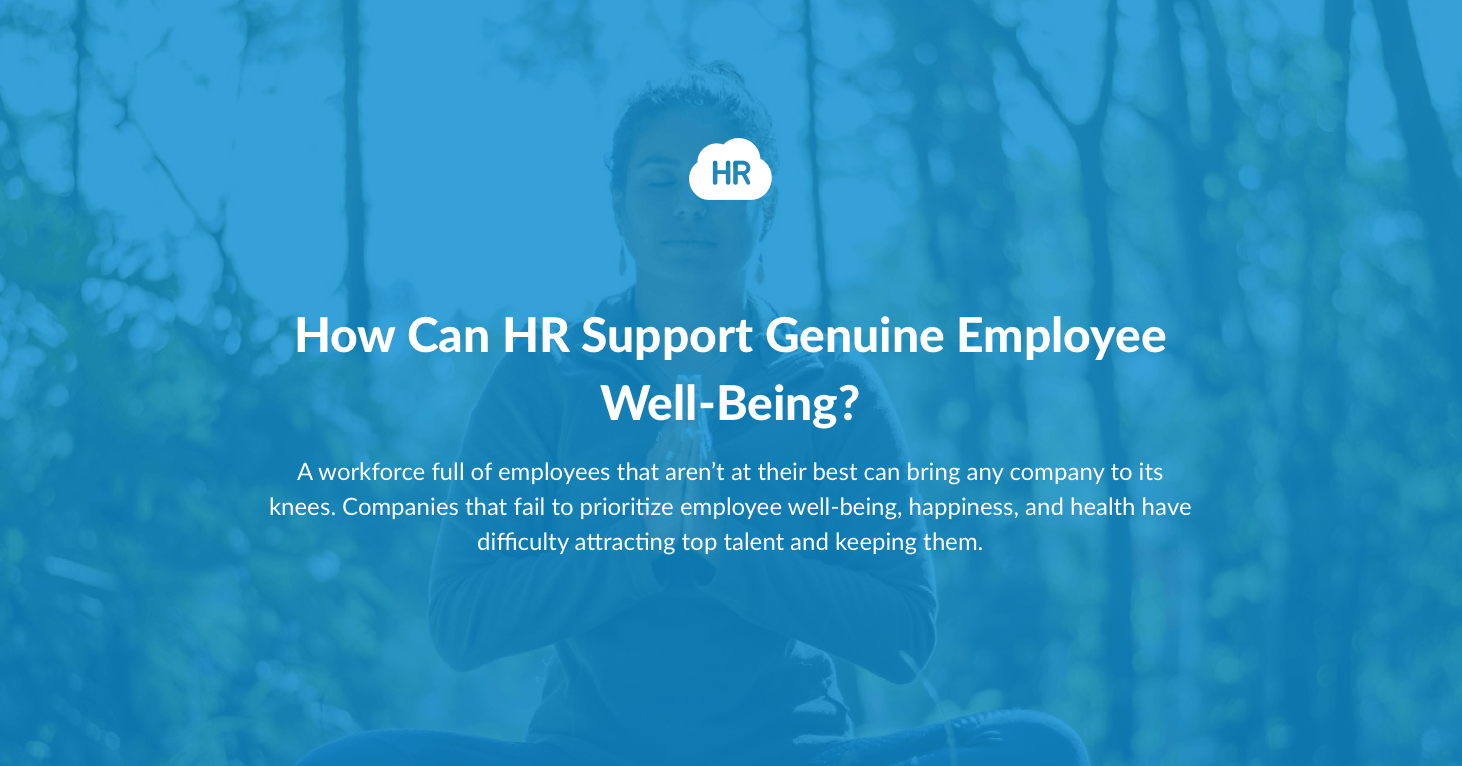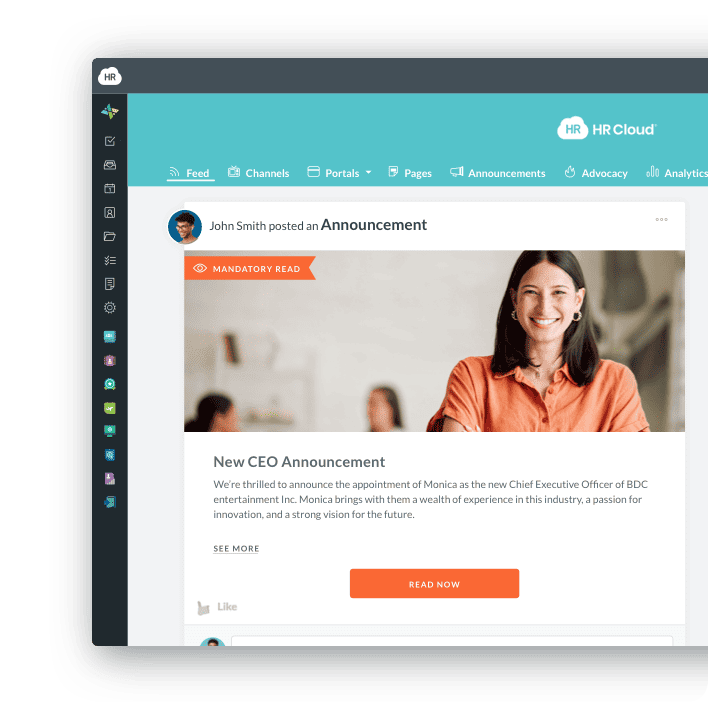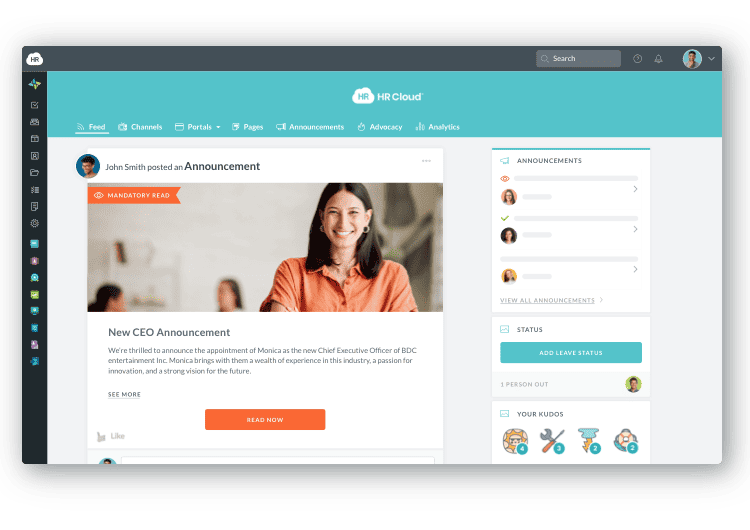How Can HR Support Genuine Employee Well-Being?

- Educate Yourself on Holistic Health and Well-being
- Build a Workplace Culture That Prioritizes Well-being
- Enable Two-Way Communication With Employees
- Exceed Expectations With Your Benefits Package and Wellness Resources
- Highlight Safety Policies, Procedures, and Equipment
- Bring the Right Leaders on Board
- Allow for Flexibility


 Cut onboarding time
by 60%—here's the
Ultimate Checklist
that helped do it.
Cut onboarding time
by 60%—here's the
Ultimate Checklist
that helped do it.

A workforce full of employees who aren't at their best can bring any company to its knees. Companies that fail to prioritize employee wellbeing, happiness, and health have difficulty attracting and keeping top talent.
In addition, the employees they do have aren't ever as productive, engaged, and motivated as they could be — and this adversely affects the company's ability to perform, provide the best for its customers, and turn a profit.
Caring about the quality of life your employees have is a much better route to take if you want your business to thrive. Human resources (HR) can play an integral role in assuring employees’ holistic health and well-being are in good standing.
Let’s look at how HR can support genuine employee well-being.
Educate Yourself on Holistic Health and Well-being 
Workplace health and wellness are usually a lot better when HR employees take it upon themselves to learn about and promote holistic health and well-being on their own time.
You'll be more empathetic to what people face every day regarding their health and their struggles to make well-being a priority. This leads to better solutions for employees in the workplace and more comprehensive support for physical, mental, and emotional health.
Become well-versed in:
-
What well-being is and how to support employee well-being
-
Substance abuse, addiction, and recovery
-
Physical health and the most common illnesses
-
How to assist people in various health and wellness crises
-
Different mental health challenges and how people living with them navigate life
-
How a person’s physical, mental, and emotional health impacts their personal and professional lives
You can go at your own pace by diving into internet research, following health and wellness experts on social media, and taking free courses and classes on holistic health. You can also pursue traditional education opportunities to grow your health-related knowledge.
Build a Workplace Culture That Prioritizes Well-being
After learning about well-being and what to do to support it, start building a workplace culture that represents your company's commitment to bettering your employees’ quality of life and improving employee well-being.
For example, don't let long hours, skipped lunches, and silenced health and well-being needs become "the norm" in your work environment. Instead, build a company culture that:
-
Is positive, authentic, transparent, and provides organizational support
-
Understands employee needs and accommodates them
-
Has dedicated resources for employee well-being benefits
-
Has leaders with varying abilities, experiences, and backgrounds
-
Openly discusses mental, physical, and emotional health and wellness in the workplace
-
Provides employees with a healthy workplace full of ergonomic equipment, greenery, good air quality, and nutritious food and drink options
You may have to work with stubborn company leaders and be willing to go to bat for your employees to create a workplace culture that prioritizes well-being — but the work will be worth it when you see how much a safe, supportive space in the workplace means to your employees.


Enable Two-Way Communication With Employees
While building a company culture that supports genuine employee wellbeing, it's also good to include employees in the process. If you can directly communicate with your employees about how to better support their well-being, do it.
First, get to know your employees personally. For example, chat with them about their family, home life, personal goals, passions, and interests outside of work. Then, move the conversation toward health-related topics and their perspective on health and well-being. Finally, encourage employees to share their thoughts on how your company can better support their holistic health and reduce occupational stress.
Many of your employees will give you fantastic advice and suggestions on how to best support their health and well-being. Absorb what they share with you, document it, and implement those suggestions one at a time to build a solid support system for them at work.
Exceed Expectations With Your Benefits Package and Wellness Resources 
If you genuinely want to give your employees support in the pursuit of health and well-being, exceed their expectations regarding your benefits package and additional wellness resources.
For example, instead of offering a "one-size fits all" wellness program in your workplace, offer one your employees can personalize based on their unique health and wellness needs and goals. Allow them to pick which resources they need, connect with specialists, and determine how long their program lasts.
You should also exceed expectations regarding the benefits package you offer your employees. Full and part-time employees deserve quality health, dental, and vision benefits that include general services like yearly health screenings for women and men. They should also have next-level services like surgery or outpatient treatment that are low-cost and easy to manage.
Include the following in your benefits package to support employee wellbeing:
-
Short and long-term disability benefits
-
Paid vacation, sick, and personal days
-
A 401(k) contribution match
-
A solid compensation package
-
Free gym memberships
-
Access to mental health support and services
-
Paid maternal, paternal, medical, and stress leave
-
Low cost or free mindfulness, meditation, and yoga classes
Highlight Safety Policies, Procedures, and Equipment
Looking out for your employees' well-being also means sharing all safety policies and procedures with them and ensuring they have any equipment they need to perform their job responsibilities with ease.
For example, if your employees spend a lot of time on tech devices, provide them with accessories like blue light glasses to help with the adverse effects of constant blue light exposure. Also, be sure they have the software and hardware they need to do their jobs.
Supply them with any safety apparel they need. Additionally, upgrade old equipment and train your employees to use the new equipment properly — this helps to ensure everyone is empowered to do their jobs well without the stress of unsafe working conditions and reduces job stress.
Bring the Right Leaders on Board 
HR will have a much easier time supporting genuine employee wellbeing when company leaders support the same thing. Therefore, it's essential to recruit and hire leaders who value wellness over work for your company.
When you bring the right leaders on board, you can create and get health and wellness resources approved much quicker. You'll also have people in higher positions who walk the wellness walk rather than just talk about it.
Welcome HR leaders to your team who understand the importance of employee wellbeing, are committed to supporting holistic health, and can lead by example. Hiring leaders who are transparent about their journey with mental, physical, and emotional health makes it easier for the rest of the workforce to do the same.
Allow for Flexibility
One of the best ways to support genuine employee wellbeing is to ensure they have a healthy, happy personal life. Of course, you want your employees to love their jobs and find meaning in their work. But you don't want work to become their sole focus because it often results in burnout, increased stress, and less motivation.
Allow your employees workplace flexibility in their work schedules and responsibilities to have ample time for family, friends, relaxation, personal passions, projects, and goals. This can include options for remote work or hybrid work arrangements. Flexible work practices can significantly reduce work-family conflict and improve work satisfaction. Also, encourage employees to completely detach from work once they clock out. This makes for better work-life balance for everyone.
Lastly, be proactive about ensuring your employees use all of their vacation days and sick/personal days wherever they need them. The narrative should be that rest and rejuvenation are always available to employees and that they won't be shunned for taking time for themselves.
Conclusion
It's crucial for HR to support genuine employee wellbeing so that workers can be their best and do their best for your company. By implementing the tips above, you can do your part to ensure that your employees have adequate support for their holistic health and wellness, leading to improved employee well-being, increased job satisfaction, and a more productive work environment.

Keep Reading
15 Proven Ways to Create a Healthy Work Environment (2026 Guide)
A healthy work environment is a workplace where employees experience psychological
Best Workday Alternatives for Mid-Market Companies in 2026: Complete HRIS Comparison Guide
"We implemented Workday and our HR team still can't figure out half the features six
Company Culture Software: How to Build a Thriving Workplace in 2026
Ask any business leader what drives lasting organizational success, and you'll hear
Like What You Hear?
We'd love to chat with you more about how HR Cloud® can support your business's HR needs. Book Your Free Demo

Build a Culture of Recognition. Boost Engagement. Guaranteed.
Workmates empowers employees to stay informed, connected, and appreciated—whether they’re on the front line, in the office, or remote. Recognition drives 12x higher engagement.Trusted by industry leaders in every sector




Cut Onboarding Costs by 60%.
Take the confusion and follow-ups out of onboarding with automated workflows, digital forms, and structured portals—so new hires ramp faster 3X quicker.Trusted by industry leaders in every sector




